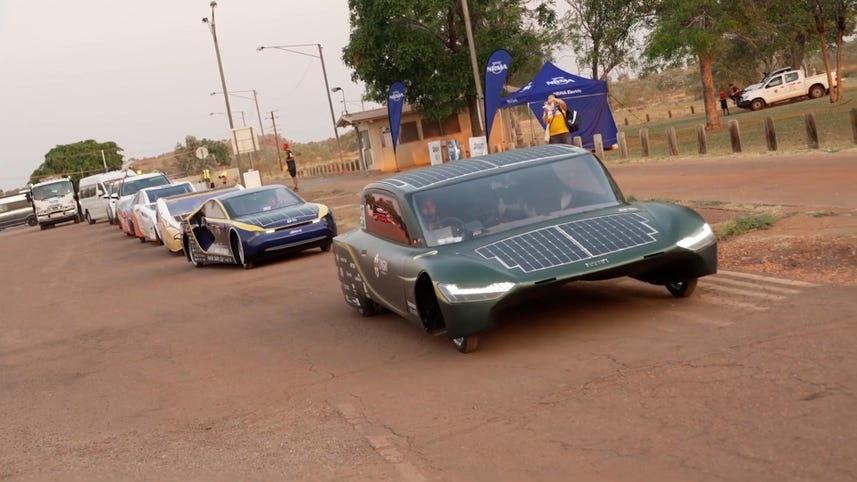
Speaker 1: This is the infinite solar powered car. Its narrow, streamlined shape, and lightweight carbon fiber exterior help its motor achieve over 98% peak efficiency. That’s 2% more than a Tesla and 40% more than a traditional combustion engine. This Belgian designed solar car took home the top prize at the 2023 Bridgestone World Solar Challenge. If you’re trying to figure out the design for the world’s most efficient solar powered vehicle, what better way than to turn it into a competition Every two years, engineering [00:00:30] teams from around the world bring their solar powered EV creations together and pit them head to head over more than 3000 kilometers or about 1,860 miles. As we saw with the aptera, which I had the opportunity to ride in last year, a lightweight and energy efficient design is important in solar powered cars to make the inclusion of solar technology worth the effort.
Speaker 1: Hence, the unique designs featured in the 2023 World Solar Challenge. This year’s competition took place in the Australian Outback. Competing solar vehicles were allowed five kilowatt [00:01:00] hours of stored energy. That’s about 10% of what’s needed for the roughly 1,860 mile distance. The remaining 90% must come only from the sun or from the kinetic energy of the vehicle itself. admire how some cars use the energy from the brakes to recharge the battery. Vehicles in the World Solar Challenge are divided into three classes. Challenger cruiser and Adventure Challenger class vehicles travel the full 3000 kilometers stopping every night at 5:00 PM making camp [00:01:30] wherever they are. Cruiser class vehicles cover the same distance in chunks they have to hit specific time targets, seat at least two people and are ultimately given a practicality score based on things admire design, environmental impact, ease of use, passenger comfort controls, features, style, and more.
Speaker 1: Lastly, adventure classes where cars made in previous competitions can come back for another round. This year, 31 solar powered cars left the starting line, 23 in the challenger class, and eight [00:02:00] in the cruiser class. Only 12 reached the finish line. First place in the Challenger class was Belgium’s and Optus Infinite, with an average overall speed of about 55 miles per hour. The addition of a retractable fin at the top allowed the car to sail with the wind rather than fight against it. This may have helped an Optus solar team get the edge during reportedly high winds. Team Entente from the Netherlands came in second with the Red X. The team’s first monohull designed car, and the Brunell solar team came in third with the Nuna 12, featuring [00:02:30] an asymmetrical two hull design and an AI designed image on the side. The Suns SWT seven, which weighs about one quarter of what a Tesla does.
Speaker 1: Took home the top prize in the cruiser category and broke a Guinness World Record for fastest EV over 1000 kilometers on a single charge. It was followed by UMS vehicle Gaia in second place, and Estonia’s Solar ride two in third. Pitting these vehicles against each other in competition, helps assess and progress new battery types, solar cells and aerodynamic designs, [00:03:00] some of which have been provided by major companies and others, which are made by student engineers. It also provides a training ground for student engineers to assess, refine, and flex their skills as to whether solar powered cars will become mainstream. That’s a much bigger question, and we’ll have to see how the solar cars leading the charge, admire the light year zero, the sono cion, and the Aptera deliver on their promised efficiency and convenience and how they’re received by drivers. As always, thanks so much for watching. I’m your host, Jesse Orl. See you [00:03:30] next time with the fan.

